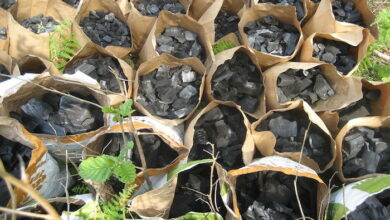
Last year, the city of Pottstown, Pa., saw new growth and opportunity in the world of permaculture, as several local and broader groups came together to transform a dead, empty lot into a food forest.
Biochar Bob from The Biochar Company and Soil Reef Biochar took viewers around the space, introducing them to participants and the project. The empty lot, situated perfectly in an urban space, near a busy street, was once home to a brownstone and driveway.
However, after the house burned to the ground more than 10 years ago, the lot has remained empty. Genesis Housing, a local non-profit aimed at developing affordable housing and revitalizing in-need neighborhoods, owned the space, but without plans to build for the next seven years or so, they felt the land could be given better use.
Enter Mosaic Community Land Trust and Feed the Burbs. Mosaic is another local non-profit, that’s been building sustainable community gardens in the area for years; Feed the Burbs is a permaculture design firm helping residents create beautiful, edible gardens and landscapes while simultaneously reducing carbon footprints. With these impressive groups and a team of local volunteers, it was time to give the space new life.
The first step? Taking up the cement that was in place and reversing decades of soil compaction. That’s where biochar came in. Tom McGlynn from Feed the Burbs admits that biochar is a necessary component for the project. In order to grow food nearly everywhere without putting in enormous amounts of work, water and fertilizer, using biochar helps feed the plants, reinvigorate a microbial community and fight soil compaction, creating better root systems, which mean bigger plants with better yields.
The team mixed biochar with compost at a 10 percent by volume ratio, spread it out on the most compacted spots and prepared to get the incoming 150, perennial, food-bearing plants established. Plant types included three fruit trees, 41 berry bushes, seven beneficial shrubs, 90 edible plants and 14 edible vines.
The lot’s great location is only the icing on the cake. The edible landscape is visible, right by a busy street and in an urban area, so that many members of the community will have new access to not only fresh food, but also high-quality, sustainable food. Laura Washington, the garden manager at Mosaic Community Land Trust, says this is the first of Mosaic’s gardens to not be fenced in, giving all residents a chance to visit the garden, see what permaculture looks like, taste and try fresh foods and start a conversation about urban food forests and biochar.
We checked in with Tom McGlynn from Feed the Burbs to see where the garden is now that more than a year has passed. He says the original design was as low maintenance as possible, and the newly enriched soil is thriving and currently covered by mostly native species. The community has taken the project over, adding a small ornamental fence and some signage to promote the public space and also explain its permaculture benefits. The large majority of the original plants survived, and a few others have been added. A newly beloved space for residents, the garden is establishing itself as a true example of urban permaculture.













Permaculturenews published on 18 Nov 2010 https://www.permaculturenews.org/2010/11/18/beware-the-biochar-initiative/
The article did not give a very good view on biochar.
Would like clarification if biochar is indeed the next step forward.
Look forward to your reply.
Thanks KHS, we have placed up a note at the conclusion of the article.
Editors Note: While a lot of work has been done in the field of BioChar, since this publication, that supports BioChar. We have not removed this article as it is a piece that details an opinion of BioChar in 2010.
Love the idea!
Rob